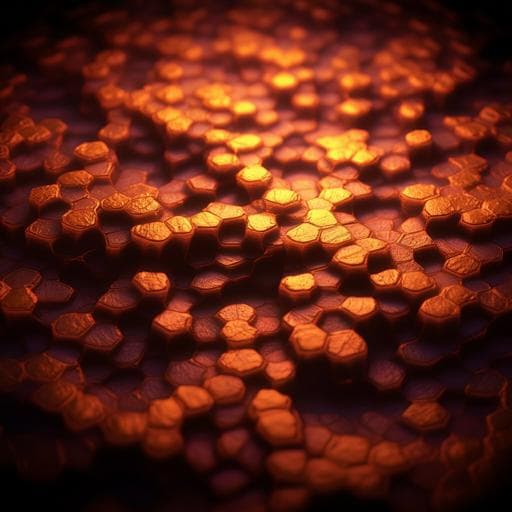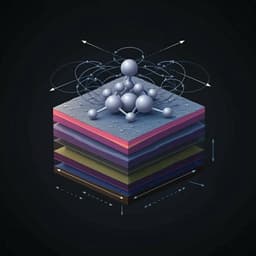
Engineering and Technology
Disorder-induced bulk photovoltaic effect in a centrosymmetric van der Waals material
C. Cheon, Z. Sun, et al.
Discover how breaking inversion symmetry through structural disorder unravels the bulk photovoltaic effect in ultrathin PtSe₂, a centrosymmetric semiconducting material. This groundbreaking research by Cheol-Yeon Cheon, Zhe Sun, Jiang Cao, Juan Francisco Gonzalez Marin, Mukesh Tripathi, Kenji Watanabe, Takashi Taniguchi, Mathieu Luisier, and Andras Kis reveals the potential of defect engineering in boosting photovoltaic functionality.
~3 min • Beginner • English
Introduction
The study investigates whether breaking inversion symmetry via structural disorder can induce the bulk photovoltaic effect (BPVE) in centrosymmetric materials. BPVE generates photocurrent/photovoltage in a single material as a second-order light–matter interaction and is not constrained by the Shockley–Queisser limit, but typically requires non-centrosymmetric crystals. Previous routes to activate BPVE in van der Waals (vdW) materials include large strain gradients, strain-induced polarization, reduced dimensionality, and strong external electric fields, all of which have practical limitations. The authors hypothesize that structural disorder, especially point defects in 2D materials, can locally break inversion symmetry and enable BPVE in otherwise centrosymmetric crystals. They select semiconducting ultrathin PtSe₂, which is centrosymmetric from monolayer to bulk due to AA stacking and has bandgaps of ~1.2 eV (monolayer) and ~0.4 eV (bilayer), as a testbed to probe disorder-induced BPVE.
Literature Review
Prior work demonstrates BPVE in non-centrosymmetric materials and its potential to surpass the Shockley–Queisser limit. In vdW materials, inversion symmetry has been externally broken using large strain gradients, flexo- (strain-induced) polarization, and reduced dimensionality, achieving high BPVE coefficients but often requiring complex device architectures prone to mechanical damage. External electric fields and ionic liquid gating can also break inversion symmetry, but require large fields and are impractical for applications. Defects are known to create trap states and locally break inversion symmetry, enabling second harmonic generation (SHG) in centrosymmetric materials; however, direct experimental evidence for disorder-induced BPVE (the DC counterpart of SHG) was lacking. In PtSe₂ specifically, defect-related phenomena such as spin–orbit splitting and Rashba interaction have been reported, motivating exploration of defect-enabled BPVE in this material.
Methodology
Materials and defect engineering: Ultrathin 2D PtSe₂ was prepared by regular tape exfoliation (RE) and Au-assisted exfoliation (AE). AE involved evaporating 100 nm Au onto bulk PtSe₂ on dicing tape, peeling with thermal release tape, transferring to SiO₂/Si at 120 °C, removing Au by KI/I₂ etchant, and cleaning (O₂ plasma, DI water, acetone, IPA). AE yields larger-area ultrathin flakes but introduces structural disorder.
Characterization: Raman spectroscopy (532 nm, 1 mW, 3000 lines/mm grating, ~1 µm² spot) assessed crystal quality. AE samples showed reduced E_g^0 peak intensity, ~1.5 cm⁻¹ redshift, and two-fold broadening versus RE, consistent with higher defect concentration (likely Se vacancies). Aberration-corrected HAADF-STEM (80 kV; 20 mrad convergence; 49–200 mrad collection; ~21 pA probe) directly visualized Se vacancies (VSe) and cluster-like defects that locally break inversion symmetry.
Device fabrication: Device #1 (bilayer PtSe₂ on Si/SiO₂) used AE PtSe₂, e-beam lithography, and 80 nm Pd contacts. Device #2 (bilayer PtSe₂ encapsulated with h-BN) incorporated local gates (Cr/Pt), bottom/top h-BN dielectrics transferred by vdW pickup (polycarbonate), cleaning and annealing, pre-contacts (Pt), final top gate and Pd contacts.
Optoelectronic measurements: Scanning photovoltage/current microscopy with 647 nm excitation (above bilayer bandgap 0.4 eV), Gaussian spot ~0.7 µm², power controlled by neutral density filters. Polarization control via linear polarizer and quarter-wave plate (for circular helicity) or half-wave plate (for linear polarization angle). Measurements at high vacuum (~10⁻⁵ mbar). Zero-bias photocurrent measured with Keithley 2450; photovoltage measured open-circuit with SR860 lock-in (723 Hz chopper).
First-principles simulations: DFT (VASP, PBE-GGA, D3 vdW, 21×21×1 k-grid, 550 eV cutoff) computed bilayer PtSe₂ band structures, with Se vacancies introduced in the top Se layer. MLWF (wannier90) provided tight-binding models (spreads <2.5 Ų). Quantum transport via NEGF with ab initio electron–photon self-energies simulated photocurrent under linearly polarized light at λ=647 nm in 40 nm slabs between semi-infinite leads. Electron and hole photocurrent components were separated by integrating energy-resolved currents over conduction and valence bands. Directional dependence and reflection probabilities at VSe were extracted by comparing pristine vs defective photocurrents for different carrier momentum directions.
Polarization analyses: Spatial photovoltage line scans between electrodes and polarization sweeps were conducted. Photovoltage vs quarter-wave plate angle θ was fit phenomenologically to Vph = L sin(4θ+δ) + C sin(2θ) + D1 θ + D2 to extract LPGE (4θ), CPGE (2θ), drift (D1), and offset (D2) components. A phenomenological LPGE expression based on C3v symmetry, electrode geometry, and light polarization gave VLPGE ∝ sin 2(α − φ + (3/2)κ). An electrode array around the flake enabled extraction of crystal zig-zag orientation from LPGE phase shifts.
Key Findings
- Structural disorder in ultrathin PtSe₂ (introduced via Au-assisted exfoliation) enables bulk photovoltaic effect (BPVE) under homogeneous illumination, despite the material being centrosymmetric in its pristine form.
- Raman spectra of AE samples show signatures of increased defects: E_g^0 peak intensity reduction, ~1.5 cm⁻¹ redshift, and two-fold broadening compared to RE samples; consistent with Se vacancies and top-layer damage. HAADF-STEM directly visualizes Se vacancies and cluster-like defects.
- Spatial photovoltage scans (λ=647 nm, P≈200 µW, spot ~0.7 µm²) show that, unlike pristine devices where response is dominated by Schottky/thermoelectric effects at metal interfaces, defective PtSe₂ exhibits maximal photovoltage when the laser is centered between electrodes, indicating a bulk (non-contact) origin consistent with BPVE.
- Polarization dependence: Photovoltage vs waveplate angle θ fits Vph = L sin(4θ+δ) + C sin(2θ) + D1 θ + D2. Defective samples exhibit significantly larger LPGE (L) and CPGE (C) amplitudes and larger polarization-independent offsets than pristine samples; photocurrent/voltage scale linearly with optical power, evidencing a second-order process.
- PDE (photon-drag effect) is unlikely to account for observations: normal incidence minimizes in-plane photon momentum; PDE cannot explain the strong contrast between defective and pristine PtSe₂, whereas BPVE requires broken inversion symmetry consistent with observed disorder.
- First-principles NEGF simulations under linearly polarized light show defective bilayer PtSe₂ yields photo-current at least an order of magnitude larger than pristine. Decomposition reveals electron–hole current imbalance localized at VSe sites.
- DFT band structures indicate a ~40 meV downshift of the top valence band edge in defective vs pristine bilayers, creating local barriers that preferentially reflect holes over electrons, breaking electron–hole symmetry and yielding a net photocurrent.
- Calculated reflection probabilities for carriers at VSe are anisotropic and exhibit 120° periodicity with polarization angle; hole reflection > electron reflection, consistent with a triangular wedge-like scattering potential lacking inversion symmetry.
- LPGE-based crystallography: Using circularly arranged electrodes, linear-polarization LPGE responses from diagonal pairs show consistent 30° phase shifts reflecting electrode geometry. Fitting yields an average zig-zag direction angle φ ≈ 43.7°, matching AFM/optical edge orientations separated by 60°, validating the VSe-driven LPGE mechanism.
- CPGE under normal incidence is attributed to defect-induced symmetry reduction (e.g., Rashba-type spin splitting from low-symmetry cluster defects), leading to helicity-dependent photocurrent sign reversal.
Discussion
The findings demonstrate that introducing structural disorder can locally break inversion symmetry in centrosymmetric PtSe₂ and activate BPVE under homogeneous illumination. In defective bilayers, LPGE and CPGE emerge robustly, whereas pristine samples show mainly interfacial photovoltaic and photothermoelectric signals. Ab initio simulations corroborate the LPGE mechanism: Se vacancies act as asymmetric trigonal scattering centers that preferentially reflect holes due to defect-induced valence band shifts, producing a net photocurrent whose magnitude and angular dependence align with experiment. The LPGE phenomenology further enables extraction of crystal orientation, presenting a practical alternative to SHG-based crystallography. CPGE at normal incidence is consistent with symmetry reduction from cluster-like defects inducing Rashba-type splitting, although a full microscopic treatment is beyond the current study. Overall, defect engineering broadens the materials palette for photovoltaic and polarization-sensitive optoelectronics by enabling BPVE in otherwise symmetry-prohibited systems.
Conclusion
This work experimentally and theoretically establishes disorder-induced BPVE in a centrosymmetric vdW semiconductor, PtSe₂. Defective bilayer PtSe₂ exhibits spontaneous LPGE and CPGE under homogeneous illumination, in stark contrast to pristine samples. First-principles quantum transport identifies Se vacancies as asymmetric scattering centers that break electron–hole symmetry and yield LPGE, while reduced local symmetry from larger defects likely enables CPGE at normal incidence. The wedge potential model mapped to VSe explains the observed anisotropy and facilitates electrical determination of crystallographic orientation. These results highlight defect engineering as a viable pathway to endow centrosymmetric materials with photovoltaic functionality, extending opportunities for light energy harvesting and polarization-sensitive detection. Future work could explore controlled defect types/densities, other centrosymmetric vdW materials, and device optimization for enhanced BPVE performance.
Limitations
- The CPGE mechanism is attributed to defect-induced symmetry reduction (e.g., Rashba splitting) based on symmetry arguments; a detailed microscopic calculation and direct band-structure measurements under identical defect conditions were not presented.
- The specific contributions of different defect types (Se vacancies vs cluster-like defects) to CPGE are not quantitatively separated; the study focuses primarily on LPGE.
- While PDE is argued to be negligible at normal incidence, a comprehensive quantitative exclusion of PDE across all experimental conditions is not provided.
- Affinity between simulated defect configurations (single VSe in a 40 nm domain) and the full experimental defect landscape (density and distribution) may introduce discrepancies in absolute magnitudes.
Related Publications
Explore these studies to deepen your understanding of the subject.







